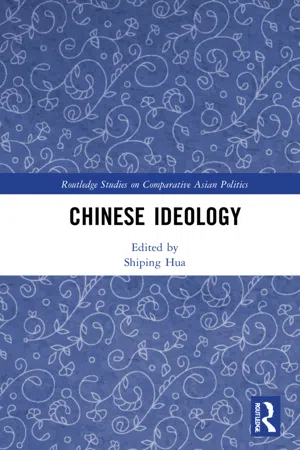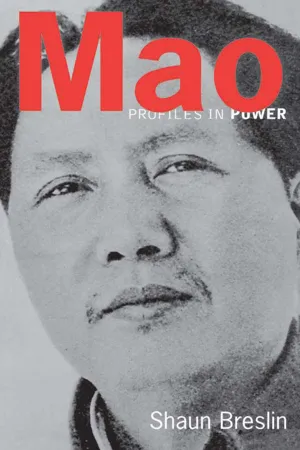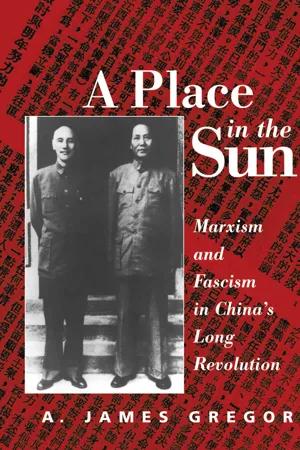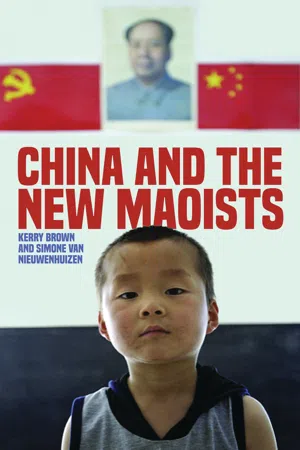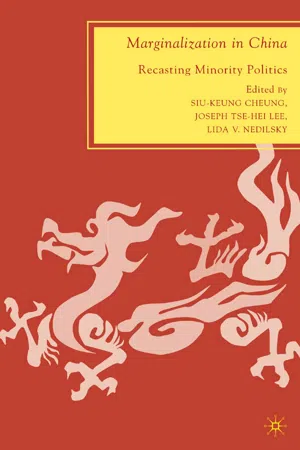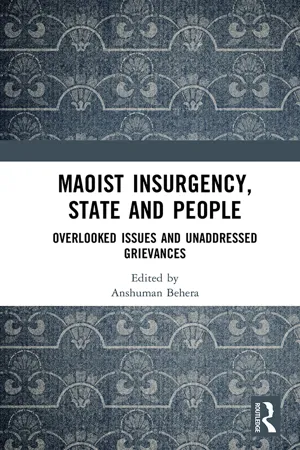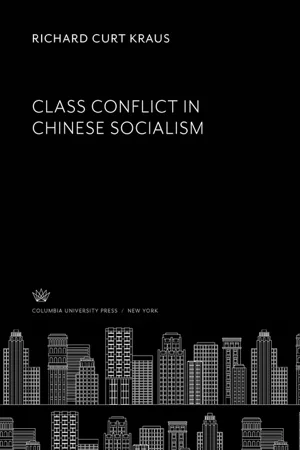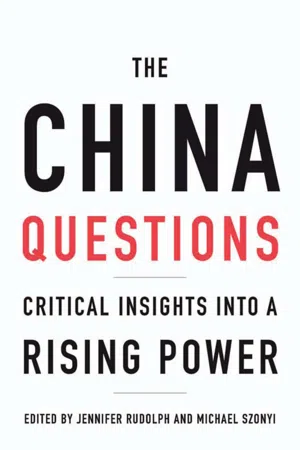Politics & International Relations
Maoism
Maoism is a political theory and practice developed by Chinese leader Mao Zedong. It emphasizes revolutionary struggle and the empowerment of the peasantry, advocating for a classless society and the continuous revolution to prevent the rise of a new ruling class. Maoism also promotes self-reliance, anti-imperialism, and the belief in the potential for rural areas to lead revolutionary change.
Written by Perlego with AI-assistance
Related key terms
1 of 5
10 Key excerpts on "Maoism"
- eBook - ePub
- Shiping Hua(Author)
- 2021(Publication Date)
- Routledge(Publisher)
Part 3Maoism as an ideology
Passage contains an image
Aminda Smith10 The living soul of Mao Zedong ThoughtDOI: 10.4324/9781003007364-10Mao Zedong was the Chairman of the Chinese Communist Party (CCP) for more than 30 years. After leading the revolution that established the People’s Republic of China (PRC) in 1949, Mao was the PRC’s supreme leader and the CCP’s paramount theorist until his death in 1976. He is known for his radical, inspiring, and often disastrous leadership. In the Soviet Union Vladimir Lenin was venerated as the visionary Marxist theorist who led the revolution, whereas his successor, Joseph Stalin, was known as the autocrat who tried to keep Russia on the socialist path. But in the People’s Republic, Mao alone is remembered as the military commander who toppled pre-revolutionary regimes, the theorist who adapted Marxism to China, and the supreme leader who presided over the PRC’s transformation into the world’s largest communist country. Thanks to his “cult of personality,” Mao became a global icon, whose image appeared on buttons, books, alarm clocks, architecture, and more. A portrait of Mao by Andy Warhol sold for nearly 50 million dollars in 2015.Mao has always been a controversial figure. In China, he is remembered by some as a champion of the poor; others revile him as a tyrant; still others view his leadership as a necessary, if tragic, step toward China’s rise as a world power. International impressions of Mao are equally diverse. Some people still revere him for the revolutionary inspiration he gave to anti-colonial and anti-capitalist movements around the globe. Others place him in a notorious trifecta of the most monstrous leaders in world history: Hitler, Stalin, Mao. How can we explain such divergent opinions? Part of the answer is that Mao, like all people, changed over time. Additionally, his ideas, at every stage of his life, were more appealing to some people than others. Finally, and most importantly, how one evaluates Mao depends on how one understands what constitutes justice, what counts as liberty, and whether, how, and at what cost, people should try to create revolutionary change. - sine qua non for all policy.. . .
Mao's Political Ideas: Revolutionary Purity or Political Pragmatism?
It is notable that Mao’s emphasis on ideology and politics reflected those areas where he was most able to set the political agenda. His ideas were not particularly strongly held within the party-state bureaucracy. As Lieberthal notes:It was thus to his advantage to maintain the primacy of the ideological debate and focus on those areas where his voice was most likely to be heard.Mao’s own position in the system would be affected by the type of economic development strategy pursued. The Chairman’s personal political strengths lay in the areas of foreign policy (especially towards the great powers), rural policy, and issues of revolutionary change.15Furthermore, Mao’s prestige was high amongst the rural masses and the young, partly as a consequence of the mass mobilisation campaigns and the development of the personality cult that will be discussed in detail in the next chapter. Again, it played to his strengths to emphasise the primacy of rural development. With the Leninists dominating policy-making, subjecting them to supervision and control from the masses who were more sympathetic to Mao’s views was also to his political benefit. Similarly, promoting party entrance for those who were politically active created a new pro-Mao constituency in the party to challenge the existing status quo and the technocratic party membership.Another consideration here is the relationship between Mao’s goals for the Chinese revolution and the influence of Soviet Marxism. The extent to which Mao ever had a firm and good grasp of the canon of Marx and Engels is open to question. It certainly appears that he came to the original works after - eBook - ePub
A Place In The Sun
Marxism And Fascimsm In China's Long Revolution
- A. James Gregor(Author)
- 2019(Publication Date)
- Routledge(Publisher)
Ideology and Development: Sun Yat-sen and the Economic History of Taiwan (Berkeley: Center for Chinese Studies, 1981), chap. 1.17. See Liu Suinian and Wu Qungan, China’s Socialist Economy: An Outline History (1949–1984) (Beijing: Beijing Review, 1986), pts. 1–2; see pp. 172–173.18. See Mao Zedong, A Critique of Soviet Economics (New York: Monthly Review Press, 1977).19. Of the twenty-three members of the politburo of the CCP before the Proletarian Cultural Revolution, only nine retained membership. Approximately two-thirds of the members of the CCP Central Committee elected in 1956 were purged. A large majority of the leaders of the CCP who had exercised leadership during the first two decades of Mao’s rule were publicly disgraced, including his heir apparent, Liu Shaoqi.20. Different factions in the party emphasized different threats. Lin Biao had identified the United States as China’s principal antagonist and apparently sought realignment with the Soviet Union to offset the threat.21. See the discussion in A. James Gregor, The Fascist Persuasion in Radical Politics (Princeton: Princeton University, 1974), chap. 6.22. The Chinese press during the Great Proletarian Cultural Revolution was filled with these charges. An easily available English-language rendering is found in Martin Nicolaus, Restoration of Capitalism in the USSR (Chicago: Liberator, 1975).23. See the discussion in A. Zelochovtsev, La Rivoluzione Culturale vista da un sovietico (Milan: Rusconi, 1971).24. See Boris Leibson, Petty-Bourgeois Revolutionism (Anarchism, Trotskyism and Maoism) (Moscow: Progress, 1970); V. Krivtsov, ed., Maoism Through the Eyes of Communists (Moscow: Progress, 1970).25. O. E. Vladimirov, ed., Maoism As It Really Is (Moscow: Progress, 1981), pp. 7, 9–11, 24, 28, 30–31, 34, 38.26. V. A. Krivtsov and V. Y. Sidikhmenov, A Critique of Mao Tse-tung’s Theoretical Conceptions - eBook - PDF
- Kerry Brown, Simone van Nieuwenhuizen(Authors)
- 2016(Publication Date)
- Zed Books(Publisher)
Hu Jintao had served as the Party boss in Tibet and Guizhou, and Jiang Zemin had worked for much of his career in Shanghai. If anyone thought Bo would be sidelined and silenced, however, they were to be proved wrong. Far from 94 CHINA AND THE NEW MAOISTS being a remote outpost, Chongqing proved to be the stage on which Bo’s aspirations could be played out even more dramatically. The roots of the Chongqing model The anxiety about a China growing rich and losing its soul in the first decade of the new century was encapsulated in one great issue: the treatment of China’s rural population. Historically, Maoism meant the application of Marxism to a country with a largely rural population. It also seems that Mao did not trouble himself to read much of Marx, even of the small proportion of his works available in Chinese translations. If he had, he would have had to deal with disparaging remarks about the relevance of the Orient, and in particular China, to the worldwide struggle for emancipation. But more seriously, Mao would have encountered a model in which the revolution was to begin primarily in industrialized countries like Germany or Great Britain. Within the urban proletariat, the furnace of rebellion and overthrow of class enemies would be achieved. In Marx’s worldview, China was barely emerging from primitive feudalism, and had a number of steps to take along the dialectic path to reach the point where a real revolution was possible. Mao’s rural roots, and his retreat to the countryside from 1927 during the years of the communists’ most intensive persecution, deepened his commitment to the peasantry and to their fundamental role in the communist cause. This was the most politically shrewd move he ever made. Peasants fought in Mao’s armies, and were the base for his support throughout the years up to 1949. Mao himself was castigated as the peasant emperor when he came to power. - eBook - PDF
Marginalization in China
Recasting Minority Politics
- Joseph Tse-Hei Lee, Lida V. Nedilsky, S. Cheung(Authors)
- 2009(Publication Date)
- Palgrave Macmillan(Publisher)
The political dimension of Christianity had a far-reaching impact on the interactions between church and state in the twentieth century. This pattern of development is similar to the growth of popular religions and their interactions with political actors and local communities in North China (Duara, 1988; Dubois, 2005; Chau, 2006). Maoism and the Church-State Relations As with the imperial states of the past, the Communist state contin- uously pursued a “united front” policy of engaging China’s Protestant communities. The purpose was to sever their ties with foreign mission- ary enterprises, to place the diverse Protestant denominations under the control of a Leninist mass organization, and to purge reactionary forces and class enemies from the church. Underlying the Communist religious policy was the ideological conflict between state and reli- gion. C. K. Yang argues that Maoist ideology was a nontheistic “faith” that manifested distinctly religious characteristics. Two aspirations of the Chinese nation express the essences of its idealistic nation: nation- alism and materialistic progress. All reforms, revolutions, and radical movements in the nineteenth and early twentieth centuries sought to promote materialistic progress and establish a strong nation. The Maoist state made the same claim, but demanded from its people the unconditional subordination of all personal concerns. This appeal by the state was based on the premise that Maoist ideology offered the only guide to China’s ultimate destiny, the only means to national independence and modernization (Yang, 1967: 381–387). Determined to emancipate the common people from religion and “superstition,” the Communist state propagated a secular, scientific, and rationalistic worldview (Smith, 2006). It denounced religion as “the opiate of the people” and an obstacle toward the socialist revolution. - eBook - ePub
Maoist Insurgency, State and People
Overlooked Issues and Unaddressed Grievances
- Anshuman Behera(Author)
- 2023(Publication Date)
- Routledge India(Publisher)
2015 ). In a normative sense, ideology should not be confused with dogma. A closer look at the Marxist-Leninist-Maoist revolutionary tradition reveals that the three magic weapons that Mao Tse Tung prescribed for the Chinese revolution are absent from the writings of Marx and Lenin. This reflects on the creative application of a universal ideology in, what Mao says, “concrete conditions.” In this sense, an ideology of an insurgency should not be guided by mere pragmatism, which offers short-term achievements. A static view of ideology often overlooks the local specificities. The Maoist insurgency movement, one of the oldest, claims to adopt a Marxist-Leninist-Maoist (MLM) revolutionary ideological framework. However, if it were the mere imposition of this ideological framework without creatively applying it in the Indian context, the movement would have experienced much more difficulties. The following section makes sense with the adoption, application, and development (if at all) of ideology by the Maoists in India.In the process of reasoning with the ideology of the Maoist insurgency, one would observe that the ideological position of the Maoists, at various stages of their movement, has been determined by the historical context and socio-political specificities. A meaningful way to understand the ideology of the Maoists could be through its longstanding ideological struggle in interacting with the international situation and, at the same time, constantly responding to the conditions (socioeconomic) in India. Though the popular discourse reflects on the Maoists adopting a Marxist-Leninist-Maoist ideological framework, the Maoists have had massive disagreements on ideology, especially after the death of Charu Majumdar in 1972. As factionalism dominated as an important feature of the armed Communist movements in India, the absence of an ideological commonality was observed in the 1970s and early 1980s. Reflecting on the ideological differences among the various factions of Indian Maoists, the leader of the Unity Center of Communist Revolutionaries of India (UCCRI), one of the significant Maoist factions, Nagi Reddy, said that:Communists in India were almost entirely without any independence of thought. A high degree of dependence manifested itself from the very start, so the wrong lines from the internationalist movement disproportionately impacted the movement. At first, it was M N Roy and CPGB. Then mechanically applying what they were told, Joshi followed the Zinoviev-Kamanev-Rykov line, Ranadive the Tito line, Ajoy Ghosh the Khruschev line, the CPI (M) the Liu Shao-Chi line, and the CPI-ML under Charu Majumdar the Lin Piao line. Just as the leaders depended on outsiders, they encouraged their cadres to depend on them. The cadres were told to follow what the leaders said, not to waste time reading too much, and to worry about discussion, but simply follow the guidelines and policies that come from above. - eBook - PDF
- Kang Liu(Author)
- 2003(Publication Date)
- University of Hawaii Press(Publisher)
The subjectivity of the agent in determining and resolving the pri-mary contradiction is of critical importance, but this subjectivity is im-mersed entirely in everyday practical and pragmatic tactics and strategies rather than based on metaphysical presumptions. Ideology therefore featured decisively in the Chinese revolution. Mao insisted: “The creation and advocacy of revolutionary theory plays the principal and decisive role in those times of which Lenin said, ‘without rev-olutionary theory there can be no revolutionary movement.’ . . . When the super structure (politics, culture, etc.) obstructs the development of the economic base, political and cultural changes become principal and deci-sive.” 7 In other words, an ideology of revolution or revolutionary con-sciousness was needed in the first place in order to create a revolutionary army, or to instill revolutionary class consciousness into the largely unself-conscious peasant masses, in a country where a well-organized modern proletariat was nearly nonexistent. Contrary to the myth created by the CCP historians that the Chinese revolution was the inevitable outcome of objective socioeconomic conditions and the only viable route toward mod-ernization, the revolution was to a large extent created by those armed with revolutionary ideologies. Hence, the Cultural Revolution, seen in the light of Mao’s continued emphasis on culture and ideology as a constitutive component of revolution and socialism, can be construed as an intrinsic movement within the revolutionary hegemony to consolidate the central position of revolutionary ideology itself. Paradoxically, when revolution was reduced to nothing more than ideology, or “the chimeras, the ideas, dogmas, imaginary beings,” then a revolution against revolution, or a “re-volt against the rule of thoughts”—the thoughts or ideology of revolution itself—was in order. - eBook - PDF
Stalin and Mao
A Comparison of the Russian and Chinese Revolutions
- Lucien Bianco(Author)
- 2018(Publication Date)
- The Chinese University of Hong Kong(Publisher)
That explains why of two Communists exercising the same power and enjoying the same privileges, one might remain faithful to his revolutionary past and be devoted to the people he has served throughout his life, while another might become a traitor. Better still, even a designated bourgeois could be transformed from within by education and self-criticism. The Maoist definition of class and class struggle therefore generated another heresy: the importance and significance of subjective forces, conscious choices, and the superstructure, to the detriment of the infrastructure. Here Mao was diverging from Marxism, for materialism and determinism were replaced with the individual’s free choice, his idealistic motivations, and, for the Supreme Leader as well as for the masses he led, a kind of voluntarism that resembled nothing less than a promethean impulse. True, that was also present in Marx himself, and even more so in Bolshevik practice. As Liss, the SS commander of the camp, reminded his prisoner, the old Communist Mostovskoy: “Do you really not recognize yourselves in us—yourselves and the strength of your will? Isn’t it true that for you too the world is your will? Is there anything that can make you waver?” 39 From the 1960s, as Mao gradually distanced himself from literal Marxism, he returned to national sources and values. As a young man, P O L I T I C S | 6 9 he had enjoyed reading anti-Confucian tirades by the May Fourth writers. For decades he—as much as if not more than anyone else—rose against tradition (e.g., the “four olds” denounced during the Cultural Revolution) and the pedants who reduced people to slavery on the pretext of honoring that tradition. In 1964, that same Mao admitted that Confucius had some qualities, then proceeded to define himself as a “native philosopher,” unlike his Communist comrades, who still adhered to foreign philosophy. - eBook - PDF
- Richard Curt Kraus(Author)
- 2019(Publication Date)
- Columbia University Press(Publisher)
M a o complained in MAOIST REVIVAL OF CLASS 77 1965 to Andre Malraux that even today, broad layers of our so-ciety are conditioned in such a way that their activity is necessarily oriented toward revisionism. They can only obtain what they want by taking it from the masses. 41 Mao had concluded that, following the socialization of private property, the source of class tensions was located in the super-structure, and that politics must be in command. But did this imply a primary focus within the superstructure on the politics of ideology (with class defined in terms of political behavior), or on the politics of institutions (with class defined in terms of relation-ship to state administration)? The first alternative suggested a class conflict directed against a kind of cultural lag from the presocialist era, while the second choice led ultimately to a far more difficult task of using class struggle to reconstitute the organizational struc-ture established by 1956. Although Mao was to turn in another decade to a conception of class linked to the state institutions of socialist China, his choice prior to the Cultural Revolution was clear. With few exceptions, he emphasized the behavioral dimension of class as he tried to make a new class analysis, consistently holding back from a full-fledged examination of the structural roots of inequality in social-ist society. Several factors guided this course, including Mao's continuing suspicions of the formerly propertied classes and un-willingness to remove them from the center of attention, and per-haps a realization that a more structurally oriented analysis of class might locate all cadres within a single hostile category. Not only was Mao uneager to identify himself and his followers as the class enemy, but his tactical sense was too shrewd to permit the polit-ical suicide which that manner of class analysis could well entail. - eBook - PDF
The China Questions
Critical Insights into a Rising Power
- Jennifer Rudolph, Jennifer Rudolph, Michael Szonyi(Authors)
- 2018(Publication Date)
- Harvard University Press(Publisher)
Rather, he will reemphasize Deng’s delineation of Marxism-Leninism and Mao Ze-dong Thought as components of the nation’s four cardinal principles that cannot be questioned. Whereas, in Deng’s time, this effectively meant putting ideology aside, Xi sees a need to revive communist ideology as a vibrant bulwark of China’s exceptionalism, to inoc-ulate its citizens against Western democratic ideas. It was presum-ably in response to Xi’s concerns that, in autumn 2015, Peking University held a world conference on Marxism, inviting some sev-enty foreign Marxists (and at least one non-Marxist foreigner, this chapter’s author) to participate. The funds are already in place for a follow-up conference. And yet, as one participant vouchsafed, sotto voce , “Marxism will do nothing for the Chinese, but they are stuck with it.” Indeed, Xi has an unenviable task. In 1949, the Chinese may not have been “poor and blank” as Mao once described them, but with a new regime firmly in power, they were at least persuaded that the regime’s ideology had to be respected. Afterward, however, the Does Mao Still Matter? 31 Chinese had to endure the ridiculous lengths to which the study of Mao Zedong Thought was emphasized in the Cultural Revolution, only to witness the demotion of ideology when Deng proclaimed that “practice was the sole criterion of truth,” opening the country to all sorts of foreign ideas. The reform era has now lasted nearly forty years, almost a decade longer than the Maoist period. The impact on young Chinese has been enormous. In particular, the demand for education in the West has skyrock-eted. The number of Chinese studying in the United States alone in 2005–2006 was over 62,500; by 2015–2016, the number had climbed to over 328,000. There are many thousands more studying at cam-puses set up by foreign universities on Chinese soil.
Index pages curate the most relevant extracts from our library of academic textbooks. They’ve been created using an in-house natural language model (NLM), each adding context and meaning to key research topics.
